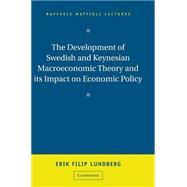
Note: Supplemental materials are not guaranteed with Rental or Used book purchases.
Purchase Benefits
What is included with this book?
| Editorial foreword | |
| First Lecture: The Theories of the Older Generation Economist - Policy Applications in the 1920s: 1. Introduction | |
| 2. The first post-war crisis | |
| 3. The analysis of Swedish economists: Knut Wicksell | |
| 4. Gustav Cassel | |
| 5. The debate on economic policies | |
| 6. The suggested instruments of economic policy | |
| Second Lecture: The Stockholm School and Keynes: The Experience of the 1930s: 7. The birth of the Stockholm school | |
| 8. The Swedish economy in the 1930s | |
| 9. General features of the Stockholm school approach to economic policy | |
| 10. The theories of the Stockholm school and their policy implications | |
| 11. The disequilibrium approach of the Stockholm school | |
| 12. Further differences between the approaches of Keynes and the Stockholm school | |
| Third Lecture: Post-War Policy Issues and Policy Theories before the 1970s: 13. Evolution of the policy environment | |
| 14. Old traditions and innovations in policy analysis | |
| 15. Gunnar Myrdal's contribution and his opponents | |
| 16. Inflationary gap theories | |
| 17. The Rehn-Meidner model and the selective fiscal policy | |
| Fourth Lecture: The Disequilibria of the 1970s and the Need for New Policy Theories 18. The imbalance of the Swedish economy: 1974-1981 | |
| 19. The deficiency of policy models | |
| 20. New policy condition | |
| 21. The failure of Keynesian policies | |
| 22. Structural problems and supply-side economics | |
| 23. The debate about the size of the public sector | |
| 24. The need for demand and supply policies | |
| 25. Supply-side policies, efficiency and equity considerations | |
| 26. Concluding remarks on the role of economists | |
| Discussion. |
The New copy of this book will include any supplemental materials advertised. Please check the title of the book to determine if it should include any access cards, study guides, lab manuals, CDs, etc.
The Used, Rental and eBook copies of this book are not guaranteed to include any supplemental materials. Typically, only the book itself is included. This is true even if the title states it includes any access cards, study guides, lab manuals, CDs, etc.